Unless you’ve sworn off social media (honestly, good for you), you’ve probably witnessed the liquid chlorophyll craze that has been sweeping across the platforms.
Like other greens, liquid chlorophyll has been linked to some seriously good health benefits—take a look at our comprehensive guide to greens powder to see what we mean.
But that’s not the only one. We’ve done more than one nutrition nerd deep dive into the benefits of chlorophyll, and really some of the most important super greens! Read our coverage on chlorella, 7 Science Backed Benefits, This is What Chlorophyll Rich, Chlorella Does to Your Body, wheatgrass, 20 Reasons Why the Benefits of Wheatgrass are Worth It, and spirulina, How to Get the 11 Mega Powerful Health Benefits of Spirulina.
But is the hype for real?
There’s some interesting research on liquid chlorophyll, and it seems to contain more than one health benefit. Just don’t expect chlorophyll and chlorophyll alone to cure all your ailments.
This article provides an in-depth look at liquid chlorophyll, including its health benefits, how it’s made, food sources, how much to use, and potential side effects. As a smart consumer, when making changes to your lifestyle, consult your primary care physician for personalized expert advice. Want to stay informed and never miss a nutrition nerd breakdown? Sign up for our newsletter.
Are you an early adopter of liquid chlorophyll? We’d love to hear about your experiences (or questions) in the comments.
What is Liquid Chlorophyll?
Liquid chlorophyll is a supplement form of chlorophyll, a natural substance found in green plants. In the plant world, chlorophyll is a pigment that gives plants their green color. It’s also an important part of photosynthesis, which is how plants get energy.
Most supplements made from the pigment actually contain chlorophyllin, a partially synthetic derivative of chlorophyll that contains copper or other minerals instead of magnesium.1 What this means is that food sources contain chlorophyll and supplements contain chlorophyllin.
Unlike natural chlorophyll, chlorophyllin is water-soluble, which means it can dissolve in water. This is thought to make supplements like liquid chlorophyll more readily absorbed than chlorophyll from foods.1 Although more research is needed to fully prove this.
Chlorophyll Health Benefits
Liquid chlorophyll benefits are mostly due to its antioxidant activity, but you’ll also find vitamins, minerals, and other nutrients in the plant pigment.2
We know from in vivo studies that the antioxidants in liquid chlorophyll scavenge free radicals and activate various detoxification pathways.2 These and other properties of chlorophyll make way for some pretty great potential health benefits.
Unfortunately, the research on liquid chlorophyll is, well, lacking overall. It’s also important to note that, while this article was meticulously researched and written by a registered dietitian, it is not a substitute for personalized expert medical advice. See your primary care physician when considering making any changes to your routine.
Here’s a look at what some of the research has to say about the benefits of chlorophyll.
Skin Benefits

Liquid chlorophyll is touted as a natural remedy for various skin ailments like acne and redness.
The bad news is there isn’t a lot of research on how chlorophyll might improve skin. But the good news is what research we do have looks pretty promising.
Copper-containing chlorophyllin has been linked to anti-inflammatory, antioxidant, and antibacterial effects that are thought to account for pore reduction, decreased redness, and less acne.3
Two pilot studies were conducted in 2015 to see whether liquid chlorophyll (in gel form) would improve skin health.
In the first study, study participants applied chlorophyllin to their sun-damaged skin two times a day for eight weeks. By the end of the trial, all 10 participants saw significant improvements in the appearance of their sun-damaged skin.4
The second study looked at chlorophyllin’s effects on both acne and large pores. The 10 participants applied the chlorophyllin gel to their skin twice daily for just three weeks. According to the researchers, the participants experienced significant improvements in their acne and large pores.5
For now, that seems to be where the research stops on liquid chlorophyll for skin health. What we can tell from these studies is that chlorophyll may improve skin issues like acne, large pores, and sun damage. It’s also worth mentioning that chlorophyllin was well-tolerated in all studies.
Cancer Prevention
Carcinogens are all around us (yuck), which means it’s important to do what you can to decrease your exposure. Liquid chlorophyll may be able to help.
Way back in 2012, when everyone was wearing peplums and statement necklaces, researchers found that chlorophyll (in the amounts found in food) provided protection from cancer. It’s thought that chlorophyll does this by blocking the bioavailability of carcinogens in the body.6
However, it should be noted that this study was performed on animals (rainbow trout, to be exact). Also, very high doses of chlorophyll were actually associated with pro-cancer activity. The lesson of this story: you really can have too much of a good thing.
In another lab study, human pancreatic cancer cells were used to assess chlorophyll’s anti-cancer activity. It was determined that chlorophyll positively changes chemical reactions that would normally cause pancreatic cancer cells to grow.7
The bottom line of this cancer research is that liquid chlorophyll may help, but no supplement can cure cancer.
Deodorant and Odor Control
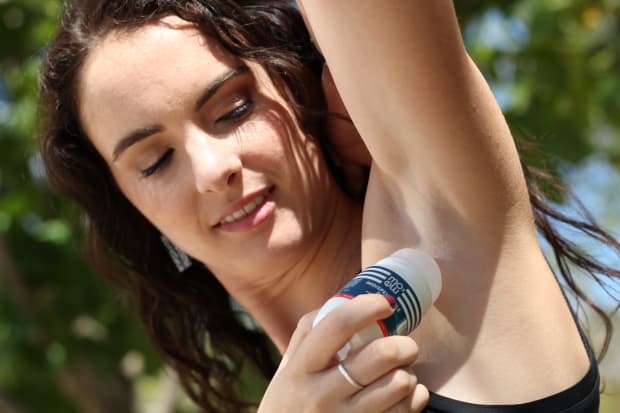
On social media, a popular use of liquid chlorophyll is as a natural deodorant. But there’s practically no research to actually back this claim up.
Chlorophyll first became a potential remedy for body odor in the 1940s and 1950s when it was found quite by accident to reduce the smells of wounded soldiers in hospitals.1
Fast forward a few decades to when a small trial on geriatric patients found that oral chlorophyllin reduced body and fecal odor.8
And then, in 2004, chlorophyll administration was linked to an increase in the production of trimethylamine N-oxide (TMAO) in people with trimethylaminuria (TMAU), a disorder that leads to an unpleasant “fishy” odor. This increase in TMAO that was caused by chlorophyll meant decreased odor in the study participants.9
This is basically where the research on this subject stops, unfortunately. And other studies that have come out have found conflicting results as to whether chlorophyll does anything at all for odor.
For now, more research is needed…and you may need to stick with your regular deodorant for a little longer.
Iron Deficiency Anemia
Iron deficiency anemia (IDA) is a global health issue. IDA occurs when you don’t have enough iron in your body and can happen for a number of reasons.10
Chlorophyllin has a structure similar to heme. Heme is a precursor to hemoglobin, the protein that binds oxygen and carries it around your body. Hemoglobin also contains iron, which is pivotal to oxygen transport.
Because chlorophyllin is structurally similar to heme, researchers have wondered if it could be a treatment option for IDA. And the answer is, maybe.
In one study, participants with IDA took Shengzuening, a supplement made up of chlorophyll derivatives, including sodium iron chlorophyllin. After one month of treatment, both adult and adolescent participants had marked improvements in their IDA, including increased hemoglobin and iron metabolism.11
These results would be expected especially since the derivative of chlorophyll used in the study contained iron instead of another mineral (like the copper found in many liquid chlorophyll supplements).
Like many other potential uses of chlorophyll, there isn’t much more research on its benefits for IDA. At least not human trials.
Can Chlorophyll Help You Lose Weight?
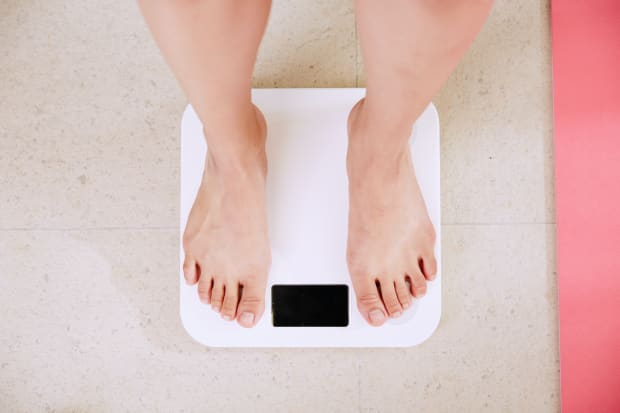
Weight loss seems to come up almost constantly as a potential benefit of many supplements. And while nothing beats an overall healthy diet and lifestyle for achieving and maintaining a healthy weight, some research suggests that liquid chlorophyll may play a role in helping you shed a few pounds.
In one study, 4-week-old obese mice were given chlorophyll to see if it would stop weight gain and prevent obesity in later life. It was concluded that chlorophyll helped the mice achieve healthy weights. However, the abstract from this study fails to provide details on how long supplementation lasted and how soon researchers saw these positive results.12
What we can take from this is that chlorophyll may provide some use for weight loss, but you’ll need to make additional efforts to see results. And remember that long-lasting weight loss only comes with healthy, sustainable measures. Just say no to fad diets.
Where Does Liquid Chlorophyll Come From?
As previously mentioned, liquid chlorophyll is actually chlorophyllin, a semi-synthetic derivative of chlorophyll that contains copper or other minerals instead of magnesium. Chlorophyll is found in various green foods and some dried supplements (like powders), while chlorophyllin is found in liquid chlorophyll supplements.
So, liquid chlorophyll comes from chlorophyll, just with a couple of extra ingredients (nutrients). These nutrients give liquid chlorophyll a different structure than the chlorophyll you eat in your green beans.
How is Liquid Chlorophyll Made?
Liquid chlorophyll is made by adding sodium and copper salts to chlorophyll (other minerals besides copper can be used in this process). This mixture causes the structure of chlorophyll to change, and you’re left with chlorophyllin, a water-soluble derivative that is thought to be more bioavailable.1
The ingredients in liquid chlorophyll, as well as the ratio between copper, sodium, and chlorophyll, may vary from one product to the next. Be sure to read the supplement label so you know what you’re getting.
What About Chlorophyll Water? What is it?
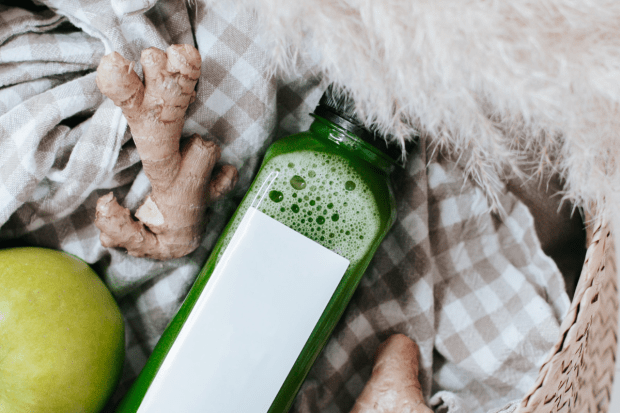
Chlorophyll water is different than liquid chlorophyll. While it’s still a chlorophyll liquid, it’s not really used the same as liquid chlorophyll.
To break it down, liquid chlorophyll comes in tinctures, extracts, and capsules that you use small amounts of every day. Chlorophyll water, on the other hand, is more like a beverage that you drink in much larger amounts.
Looking at chlorophyll water products online, you’ll see that it’s mostly water that has been enhanced with chlorophyllin and other nutrients, like vitamin C, vitamin D, and vitamin B12. It’s hard to tell if chlorophyll water contains as much chlorophyll as liquid chlorophyll, but the answer is probably no.
There aren’t studies specifically on chlorophyll water at this time. It may be a great option for hydration, but if you’re looking for chlorophyll benefits, then it may be best to stick with liquid chlorophyll supplements.
Liquid Chlorophyll vs. Spirulina and Chlorella
You may be wondering how liquid chlorophyll stacks up against other greens, like spirulina and chlorella. We’re here to clear up any confusion and let you know the benefits of each.
While chlorophyll is a substance found in plants, spirulina and chlorella are both types of green algae. But want to know the great thing? Spirulina AND chlorella contain chlorophyll.
That’s right. These algae get their green color from our friend chlorophyll. This means you can get all the benefits of chlorophyll when you choose spirulina or chlorella, plus a long list of additional nutrients.
Like liquid chlorophyll, spirulina and chlorella are sold in supplement form.
For a quick refresher:
- Spirulina is a source of protein, essential amino acids, fiber, vitamins, minerals, essential fatty acids, and antioxidants. It’s been found to possess lipid-lowering, blood sugar-lowering, and antihypertensive properties, among others.13
- Chlorella also contains protein, essential amino acids, fiber, vitamins, minerals, essential fatty acids, and antioxidants. Studies have shown that chlorella is immunomodulatory (supports the immune system), antihypertensive, and antidiabetic.14
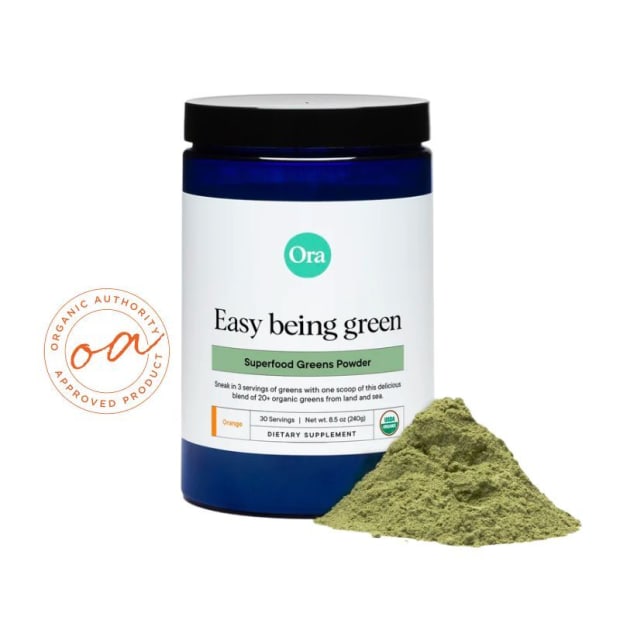
We love this tasty greens powder by Ora Organic. It covers all your nutritional bases with over 20 veggies, grasses, algae, superfoods, and adaptogenic herbs, and is rich in chlorophyll, spirulina, chlorella, and more!
You’ll love the bright citrus flavor, which comes from organic fruit and prebiotics, and makes it super easy to add nutrient-dense goodness into your daily routine.
View the original article to see embedded media.
Liquid Chlorophyll vs. Sea Moss
Sea moss is another type of algae that is often used as a dietary supplement. It’s also considered seaweed and can come in a variety of colors, including shades of green, red, purple, and brown.15 Green variations of sea moss contain chlorophyll.
Sea moss is a source of protein, fiber, iron, magnesium, zinc, and copper and continues to be researched for its many potential health benefits. Health benefits that may be attributed to sea moss include heart health, gut health, immune support, and exercise recovery.16
Foods That Are Rich in Chlorophyll
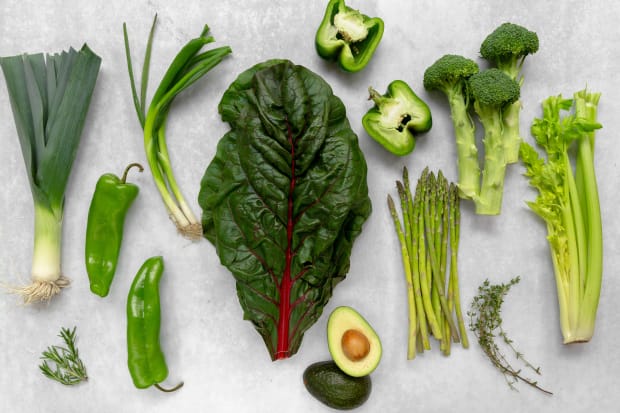
Certain vegetables are good sources of chlorophyll. An easy way to tell if a food contains chlorophyll is by its color. Foods that are green inside AND out are rich in chlorophyll.
The greener the vegetable the better when it comes to chlorophyll content. This means that dark leafy greens are high in chlorophyll. Chlorophyll can be found in:1
- Spinach
- Parsley
- Garden cress
- Green beans
- Arugula
- Leeks
- Endive
- Sugar peas
- Chinese cabbage
Recall that chlorophyll is also in algae and seaweeds, including chlorella, spirulina, and green sea moss.
Making these foods a regular part of your diet will provide the chlorophyll benefits you crave.
Can Liquid Chlorophyll Replace Vegetables?
Nothing replaces vegetables. But liquid chlorophyll can certainly be a part of a healthy diet.
There’s some thought that liquid chlorophyll may be more bioavailable than chlorophyll found in foods. This is because liquid chlorophyll dissolves in water (water-soluble) while chlorophyll from food sources dissolves in fats (fat-soluble). Nutrients that are fat-soluble take more time to digest and absorb.1
The thing about vegetables, though, is they’re chock-full of nutrition. And even though liquid chlorophyll is also nutrient-packed, it still can’t replace vegetables.
Chlorophyll is just one of many pigments found in vegetables (and fruits). Other plant pigments like beta-carotene and anthocyanins are important to your diet as well.
Vegetables are also a rich source of fiber, something liquid chlorophyll lacks. Fiber is vital to things like digestive health, heart health, and even mental health.
To put it simply, you can’t get the variety of nutrients your body needs with liquid chlorophyll alone. So if you’re interested in trying liquid chlorophyll, the best thing to do is enjoy it along with a range of vegetables.
How Much Chlorophyll Should You Take per Day?
There isn’t solid evidence when it comes to the right dosing for all the chlorophyll health benefits. Not enough human trials have been performed to give good recommendations. For this reason, there aren’t really dosage guidelines for liquid chlorophyll.
So, what do you do?
Follow the dosage directions listed on the product label of your liquid chlorophyll.
Product ingredients may vary from product to product, which is another reason why standardized dosage information doesn’t exist for liquid chlorophyll.
Doses are said to range between 100 and 300 mg (milligrams) per day of liquid chlorophyll is typically appropriate. However, this seems to mostly be information from old studies on odor control.1
If you find yourself confused about how much liquid chlorophyll to take, you can always talk with a healthcare provider. They may be able to help you to determine an appropriate dose.
Chlorophyll Side Effects
For the most part, liquid chlorophyll is thought to be a safe supplement choice, making it one less thing to worry about.
Although, in rare cases, side effects may occur when using liquid chlorophyll. These side effects may include:1
- Discoloration of urine or feces (typically green)
- Discoloration of the tongue (yellow or black)
- Diarrhea
- Mild burning or itching (when used topically)
Side effects may be more likely to occur if you take high doses of liquid chlorophyll. So follow the directions and only take what you should!
It’s also worth noting that the safety of liquid chlorophyll has not been studied in people who are pregnant or breastfeeding. If this is you, it may be best to avoid liquid chlorophyll until this season of life passes.
And even though drug interactions aren’t well-documented, be sure to talk with a pharmacist or other healthcare provider before starting liquid chlorophyll if you take any medications.
Summary
Liquid chlorophyll (also known as chlorophyllin) is a derivative of chlorophyll, an important pigment that gives many plants their green color.
Liquid chlorophyll supplements may be beneficial for a range of health concerns, like acne, large pores, body odor, iron deficiency anemia, and cancer. However, the research surrounding these health benefits is very minimal. More research is desperately needed on liquid chlorophyll.
As a final note, remember that liquid chlorophyll and other dietary supplements should never replace standard medical care. You should always talk with a healthcare provider before starting a new supplement if you have any medical conditions or take any prescription medications. This article is not a substitute for personalized expert medical advice.
P.S. Did you know? Organic Authority has its own nutrition and wellness shop to meet your needs and help you take control of your health. Shop clean supplements for energy, sleep, inner beauty for skin support, protein, workouts, pantry items, and more. Shop The Organic Authority Shop now.
Read More on Organic Authority
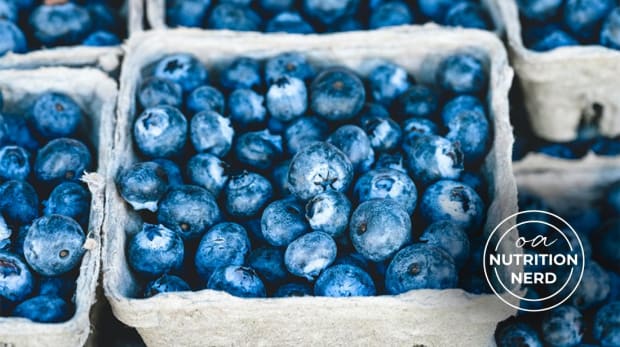
The Remarkable Health Benefits of Flax Seeds: Don’t Miss Out on This Powerful Plant’s Nutrients
The 7 Most Ultimate Seeds: Superfoods Made Easy
The Best Foods for Longevity? Blue Foods Are Key Experts Say
References
1. https://lpi.oregonstate.edu/mic/dietary-factors/phytochemicals/chlorophyll-metallo-chlorophyll-derivatives
2. https://www.ncbi.nlm.nih.gov/pmc/articles/PMC7346216/
3. https://pubmed.ncbi.nlm.nih.gov/26461829/
4. https://pubmed.ncbi.nlm.nih.gov/25844615/
5. https://pubmed.ncbi.nlm.nih.gov/26091384/
6. https://www.ncbi.nlm.nih.gov/pmc/articles/PMC3486520/
7. https://www.hindawi.com/journals/omcl/2018/4069167/
8. https://agsjournals.onlinelibrary.wiley.com/doi/10.1111/j.1532-5415.1980.tb00124.x
9. https://www.sciencedirect.com/science/article/abs/pii/S0024320504001146?via%3Dihub
10. https://www.nhlbi.nih.gov/health/anemia/iron-deficiency-anemia
11. https://www.hindawi.com/journals/ecam/2019/8796234/
12. https://onlinelibrary.wiley.com/doi/10.1002/mnfr.201801219
13. https://www.hindawi.com/journals/omcl/2017/3247528/
14. https://www.mdpi.com/2072-6643/12/9/2524
15. https://www.healthline.com/nutrition/seamoss#what-it-is
16. https://health.clevelandclinic.org/sea-moss-benefits/
Source link

